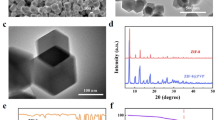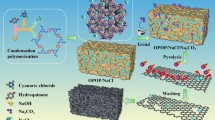Abstract
ZIF-derived carbon structures are considered as desired electrode materials for supercapacitors due to their high surface area, high conductivity, and porous structure. However, the most reported ratio of 2-methylimidazole and Zn(II) is 4:1 to 20:1, which limits commercial applications due to the increasing cost. In this paper, a multirole Zn(II)-assisted method is presented from Zn(II) solution, ZnO, ZnO/ZIF-8 core-shell nanostructure, to 3D hierarchical micro-meso-macroporous carbon structures with a 1:1 ratio of 2-methylimidazole and Zn(II). The hierarchically porous carbon has a high surface area of 1800 m2 g−1 due to the synergistic effect of multirole Zn(II). The unique carbon-based half-cell delivers the specific capacitances of 377 and 221 F g−1 at the current densities of 1.0 and 50 A g−1, respectively. As a 2.5 V symmetrical supercapacitor, the device reveals a high double-layer capacitance of 24.4 F g−1, a power density of 62.5 kW kg−1, and more than 85.8% capacitance can be retained over 10000 cycles at 10 A g−1. More importantly, the low-cost hierarchically porous carbon could be easily produced on a large scale and almost all chemicals can be reused in the sustainable method.
Similar content being viewed by others
References
Liu L, Niu Z, Chen J. Unconventional supercapacitors from nano-carbon-based electrode materials to device configurations. Chem Soc Rev, 2016, 45: 4340–4363
Chen K F, Xue D F. Rare earth and transitional metal colloidal supercapacitors. Sci China Tech Sci, 2015, 1768–1778
Zhou K, Fan X J, Wei X F, et al. The strategies of advanced cathode composites for lithium-sulfur batteries. Sci China Tech Sci, 2017, 60: 175–185
Meng F, Li Q, Zheng L. Flexible fiber-shaped supercapacitors: Design, fabrication, and multi-functionalities. Energy Storage Mater, 2017, 8: 85–109
Zhang Q Z, Zhang D, Miao Z C, et al. Research progress in MnO2-carbon based supercapacitor electrode materials. Small, 2018, 14: 1702883
Zhang G, Chen Y, Chen Y, et al. Activated biomass carbon made from bamboo as electrode material for supercapacitors. Mater Res Bull, 2018, 102: 391–398
Wang Y, Fugetsu B, Wang Z, et al. Nitrogen-doped porous carbon monoliths from polyacrylonitrile (PAN) and carbon nanotubes as electrodes for supercapacitors. Sci Rep, 2017, 7: 40259
Meng F, Zheng L, Luo S, et al. A highly torsionable fiber-shaped supercapacitor. J Mater Chem A, 2017, 5: 4397–4403
Meng F, Zhao J, Ye Y, et al. Carbon nanotube fibers for electrochemical applications: Effect of enhanced interfaces by an acid treatment. Nanoscale, 2012, 4: 7464–7468
Huang Y B, Liang J, Wang X S, et al. Multifunctional metal-organic framework catalysts: Synergistic catalysis and tandem reactions. Chem Soc Rev, 2017, 46: 126–157
Li J, Wang X, Zhao G, et al. Metal-organic framework-based materials: Superior adsorbents for the capture of toxic and radioactive metal ions. Chem Soc Rev, 2018, 47: 2322–2356
Salunkhe R R, Kaneti Y V, Kim J, et al. Nanoarchitectures for metal-organic framework-derived nanoporous carbons toward supercapacitor applications. Acc Chem Res, 2016, 49: 2796–2806
Yu J, Xie L H, Li J R, et al. CO2 capture and separations using MOFs: Computational and experimental studies. Chem Rev, 2017, 117: 9674–9754
Yuan S, Feng L, Wang K, et al. Stable metal-organic frameworks: Design, synthesis, and applications. Adv Mater, 2018, 30: 1704303
Chen L F, Lu Y, Yu L, et al. Designed formation of hollow particle-based nitrogen-doped carbon nanofibers for high-performance super-capacitors. Energy Environ Sci, 2017, 10: 1777–1783
Li W, Hu S, Luo X, et al. Confined amorphous red phosphorus in MOF-derived N-doped microporous carbon as a superior anode for sodium-ion battery. Adv Mater, 2017, 29: 1605820
Zhang J, Huang M, Xi B, et al. Systematic study of effect on enhancing specific capacity and electrochemical behaviors of lithium-sulfur batteries. Adv Energy Mater, 2018, 8: 1701330
Abdi J, Vossoughi M, Mahmoodi N M, et al. Synthesis of metal-organic framework hybrid nanocomposites based on GO and CNT with high adsorption capacity for dye removal. Chem Eng J, 2017, 326: 1145–1158
Mohamedali M, Ibrahim H, Henni A. Incorporation of acetate-based ionic liquids into a zeolitic imidazolate framework (ZIF-8) as efficient sorbents for carbon dioxide capture. Chem Eng J, 2018, 334: 817–828
Liu Q, Liu X, Zheng L, et al. The solid-phase synthesis of an Fe-N-C electrocatalyst for high-power proton-exchange membrane fuel cells. Angew Chem Int Ed, 2018, 57: 1204–1208
Liu S, Chen F, Li S, et al. Enhanced photocatalytic conversion of greenhouse gas CO2 into solar fuels over g-C3N4 nanotubes with decorated transparent ZIF-8 nanoclusters. Appl Catal B-Environ, 2017, 211: 1–10
Pan Y, Sun K, Liu S, et al. Core-shell ZIF-8@ZIF-67-derived CoP nanoparticle-embedded N-doped carbon nanotube hollow polyhedron for efficient overall water splitting. J Am Chem Soc, 2018, 140: 2610–2618
Shen K, Zhang L, Chen X, et al. Ordered macro-microporous metal-organic framework single crystals. Science, 2018, 359: 206–210
Lupica-Spagnolo L, Ward D J, Marie J J, et al. Pollen-like ZIF-8 colloidosomes via emulsion templating and etching. Chem Commun, 2018, 54: 8506–8509
Cao X M, Han Z B. Hollow core-shell ZnO@ZIF-8 on carbon cloth for flexible supercapacitors with ultrahigh areal capacitance. Chem Commun, 2019, 55: 1746–1749
Li X, Hao C, Tang B, et al. Supercapacitor electrode materials with hierarchically structured pores from carbonization of MWCNTs and ZIF-8 composites. Nanoscale, 2017, 9: 2178–2187
Wan L, Shamsaei E, Easton C D, et al. ZIF-8 derived nitrogen-doped porous carbon/carbon nanotube composite for high-performance supercapacitor. Carbon, 2017, 121: 330–336
Afzal A, Abuilaiwi F A, Habib A, et al. Polypyrrole/carbon nanotube supercapacitors: Technological advances and challenges. J Power Sources, 2017, 352: 174–186
Chee W K, Lim H N, Zainal Z, et al. Flexible graphene-based supercapacitors: A review. J Phys Chem C, 2016, 120: 4153–4172
Wang J, Luo X, Young C, et al. A glucose-assisted hydrothermal reaction for directly transforming metal-organic frameworks into hollow carbonaceous materials. Chem Mater, 2018, 30: 4401–4408
Kuang Q, Xu T, Xie Z X, et al. Versatile fabrication of aligned SnO2 nanotube arrays by using various ZnO arrays as sacrificial templates. J Mater Chem, 2009, 19: 1019–1023
Zhan W, Kuang Q, Zhou J, et al. Semiconductor@metal-organic framework core-shell heterostructures: A case of ZnO@ZIF-8 nanorods with selective photoelectrochemical response. J Am Chem Soc, 2013, 135: 1926–1933
Huang X C, Lin Y Y, Zhang J P, et al. Ligand-directed strategy for zeolite-type metal-organic frameworks: Zinc(II) imidazolates with unusual zeolitic topologies. Angew Chem, 2006, 118: 1587–1589
Zhu Y, Murali S, Stoller M D, et al. Carbon-based supercapacitors produced by activation of graphene. Science, 2011, 332: 1537–1541
Lin T, Chen I W, Liu F, et al. Nitrogen-doped mesoporous carbon of extraordinary capacitance for electrochemical energy storage. Science, 2015, 350: 1508–1513
Jin Z Y, Lu A H, Xu Y Y, et al. Ionic liquid-assisted synthesis of microporous carbon nanosheets for use in high rate and long cycle life supercapacitors. Adv Mater, 2014, 26: 3700–3705
Wang J, Tang J, Ding B, et al. Self-template-directed metal-organic frameworks network and the derived honeycomb-like carbon flakes via confinement pyrolysis. Small, 2018, 14: 1704461
Chen L F, Zhang X D, Liang H W, et al. Synthesis of nitrogen-doped porous carbon nanofibers as an efficient electrode material for supercapacitors. ACS Nano, 2012, 6: 7092–7102
Wickramaratne N P, Xu J, Wang M, et al. Nitrogen enriched porous carbon spheres: attractive materials for supercapacitor electrodes and CO2 adsorption. Chem Mater, 2014, 26: 2820–2828
Indra A, Menezes P W, Kailasam K, et al. Nickel as a co-catalyst for photocatalytic hydrogen evolution on graphitic-carbon nitride (sg-CN): What is the nature of the active species? Chem Commun, 2016, 52: 104–107
Liu Y, Yu L, Ong C N, et al. Nitrogen-doped graphene nanosheets as reactive water purification membranes. Nano Res, 2016, 9: 1983–1993
Jiang M, Cao X, Zhu D, et al. Hierarchically porous N-doped carbon derived from ZIF-8 nanocomposites for electrochemical applications. Electrochim Acta, 2016, 196: 699–707
Chabot V, Higgins D, Yu A, et al. A review of graphene and graphene oxide sponge: Material synthesis and applications to energy and the environment. Energy Environ Sci, 2014, 7: 1564–1596
Lin Z, Zeng Z, Gui X, et al. Carbon nanotube sponges, aerogels, and hierarchical composites: Synthesis, properties, and energy applications. Adv Energy Mater, 2016, 6: 1600554
Wei S, Zhang H, Huang Y, et al. Pig bone derived hierarchical porous carbon and its enhanced cycling performance of lithium-sulfur batteries. Energy Environ Sci, 2011, 4: 736–740
Liu R, Wan L, Liu S, et al. An interface-induced Co-assembly approach towards ordered mesoporous carbon/graphene aerogel for high-performance supercapacitors. Adv Funct Mater, 2015, 25: 526–533
Xiao K, Ding L X, Liu G, et al. Freestanding, hydrophilic nitrogen-doped carbon foams for highly compressible all solid-state super-capacitors. Adv Mater, 2016, 28: 5997–6002
Salunkhe R R, Young C, Tang J, et al. A high-performance supercapacitor cell based on ZIF-8-derived nanoporous carbon using an organic electrolyte. Chem Commun, 2016, 52: 4764–4767
Chaudhari N K, Song M Y, Yu J S. Heteroatom-doped highly porous carbon from human urine. Sci Rep, 2014, 4: 5221
Yang W, Yang W, Ding F, et al. Template-free synthesis of ultrathin porous carbon shell with excellent conductivity for high-rate super-capacitors. Carbon, 2017, 111: 419–427
Ferrero G A, Fuertes A B, Sevilla M. N-doped porous carbon capsules with tunable porosity for high-performance supercapacitors. J Mater Chem A, 2015, 3: 2914–2923
Zhang D, Zhao J, Feng C, et al. Scalable synthesis of hierarchical macropore-rich activated carbon microspheres assembled by carbon nanoparticles for high rate performance supercapacitors. J Power Sources, 2017, 324: 363–370
Sevilla M, Fuertes A B. Direct synthesis of highly porous interconnected carbon nanosheets and their application as high-performance supercapacitors. ACS Nano, 2014, 8: 5069–5078
Yao Y, Liu P, Li X, et al. Nitrogen-doped graphitic hierarchically porous carbon nanofibers obtained via bimetallic-coordination organic framework modification and their application in supercapacitors. Dalton Trans, 2018, 47: 7316–7326
Salunkhe R R, Kamachi Y, Torad N L, et al. Fabrication of symmetric supercapacitors based on MOF-derived nanoporous carbons. J Mater Chem A, 2014, 2: 19848–19854
Author information
Authors and Affiliations
Corresponding authors
Rights and permissions
About this article
Cite this article
Xu, L., Meng, F., Wei, X. et al. Large-scale multirole Zn(II) programmed synthesis of ultrathin hierarchically porous carbon nanosheets. Sci. China Technol. Sci. 63, 1730–1738 (2020). https://doi.org/10.1007/s11431-019-1510-0
Received:
Accepted:
Published:
Issue Date:
DOI: https://doi.org/10.1007/s11431-019-1510-0




